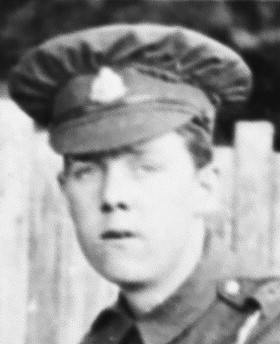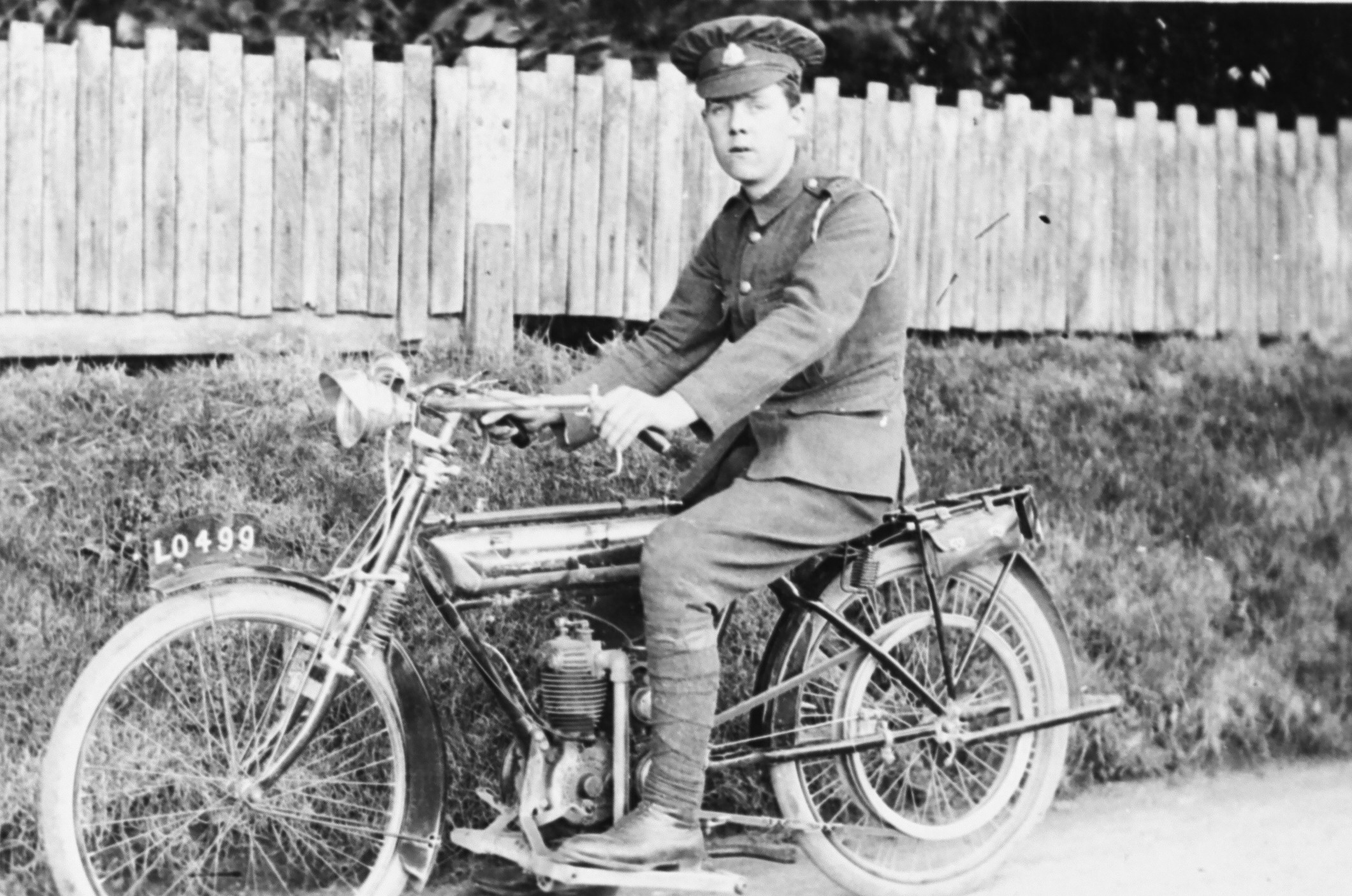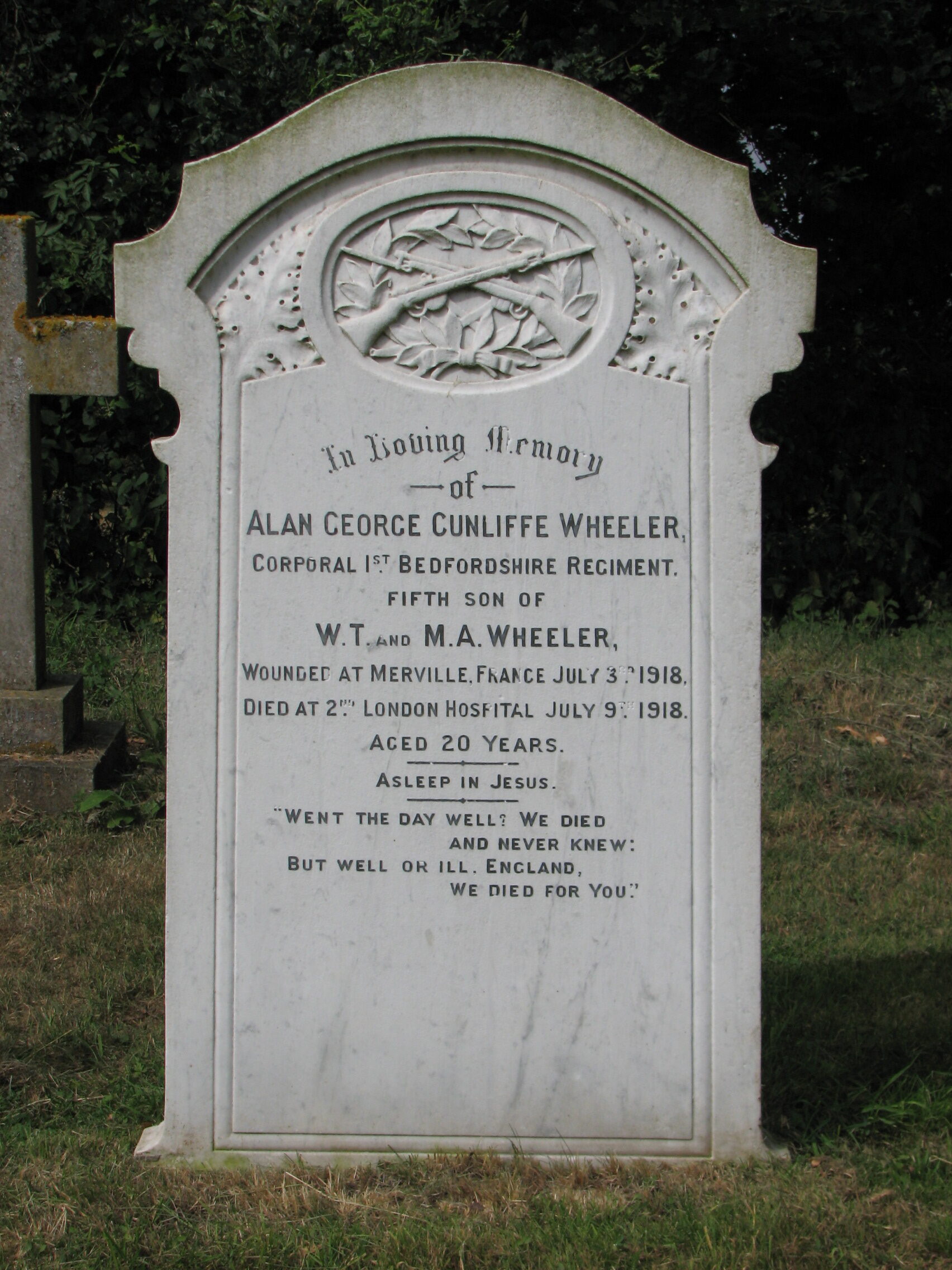Alan Wheeler (1897 - 1918)
A soldier in the Territorial Force, Alan was initially too young to serve overseas so was engaged in coastal defence duties in eastern England. He later served on the Western Front and also in Italy, with the 1st Battalion of the Bedfordshire Regiment.
- 66
- Died in the Great War
- 51.977427, 1.029527
Details
| Name: | Alan George Cunliffe Wheeler |
| Service: | British Army |
| Unit: | 1st Battalion, Bedfordshire Regiment |
| Regimental Number: | 205872 |
| Rank: | Corporal |
| Date of Death: | 9th July 1918 |
| Age: | 20 |
| Buried: | East Bergholt Cemetery |
Family Background and Early Life
Alan Wheeler was born in East Bergholt on 4th September 1897, one of the younger children of William Thomas Wheeler and his wife Mary Ann.
William was originally from East Bergholt but had spent part of his childhood in Stutton. He started off as a Bricklayer, but by his late ‘20s William was employing others and became a Builder and Contractor. His business was based just off Puttock’s Lane, in what is still called Wheeler’s Yard.
Alan’s mother was born Mary Ann Stedman in West Horsley in Surrey. She later moved to the nearby village of Great Bookham, and it was in the Parish Church there that she married William Wheeler, on 27th December 1883, when they were both aged 21. Together they would have thirteen children, of whom four died in infancy. 1 Four of Alan’s brothers also served in the Armed Forces during the Great War; all survived the War.
Geoffrey Wheeler served for most of the War in the Army Service Corps, disembarking in France in 1914. In 1918, he transferred to the Royal Air Force.
Herbert and Hugh Wheeler both saw home service in Canada, in the Royal Air Force.
Marcus Wheeler served in the Army Service Corps on the Western Front. During the course of the War, he rose from the rank of Private to that of Captain.
William and Mary made their home in East Bergholt, initially on what was then called Manningtree Road.
Young Alan started at the village school at Burnt Oak in May 1902, but left there less than two years later to attend the private school at Sherman’s Hall in Dedham. He left Sherman’s Hall in 1907 and attended the Ipswich Municipal Secondary School for Boys (located on Tower Ramparts), as a Day Scholar.
By the time that Alan started school in Ipswich, the Wheeler family had moved into Parkfield House, which still stands next to Wheeler’s Yard.
Alan left the School for Boys on 26th July 1911, and that institution’s records state that the occupation he took up after leaving was “Farming in the Colonies”. Due to the vagaries of the surviving passenger lists, it is not currently known where Alan went abroad, or even if he went. It is also noteworthy that Alan’s occupation on his Death Certificate is shown as Carpenter, there is no mention of anything related to farming.
Joins the Territorial Force
In the event that Alan did go abroad, then certainly at some point before the end of September 1914 he had returned to Great Britain and had joined the 6th Battalion of the Suffolk Regiment. The 6th was part of the Territorial Force (the forerunner of the Territorial Army) and was also a Cyclist battalion. 2 The Cyclist battalions – who as the name suggests used bicycles for transportation – were intended to be used for reconnaissance and carrying messages, whilst also serving as infantry when required.
Following the declaration of war, every man of military age in the 6th Battalion volunteered for service overseas. However, this did not include Alan as – at this time – a soldier had to be at least 19 years old to serve overseas in a theatre of war. Alan only turned 17 one month after War was declared and as a result would spend the next three years engaged in home defence duties, initially in Suffolk and later – probably – in Lincolnshire.
Alan’s Service Record does not survive, but other evidence indicates that that he was sent to France on 12th October 1917. Upon arrival, Alan was nominally posted to the 8th Battalion of the Suffolk Regiment, though he never actually joined them in the field. From 1916 onwards, it had become common for an infantry soldier to be transferred to another regiment upon arrival in France.
France, Belgium and Italy
Within a few days of disembarking in France, Alan and another 25 men were transferred out of the 8th Suffolks to the 1st Battalion of the Bedfordshire Regiment, who were at that time in Belgium. That Battalion had been on the Western Front since 1914, and though it was a pre-war Regular unit, by the time that Alan joined it, most of the men – like him – would have been replacements.
Just one week after joining the 1st Bedfords, the Battalion were back in the front line. This was the closing weeks of the Third Battle of Ypres (commonly called the Battle of Passchendaele), and the 1st Bedfords were in the line west of the village of Gheluvelt.
The Battalion finally left the Ypres Salient in the middle of November. Early the following month, they were sent to Italy as part of the Italian Expeditionary Force.
The Italian Army had recently suffered a major defeat at the hands of the Austrians and Germans at the Battle of Caporetto – this threatened the collapse of the whole Italian Front, and potentially could have led to Italy’s withdrawal from the War. In response to this, the British and French organised the joint Italian Expeditionary Force, which was sent to reinforce the Italians.
Thanks in part to the men and supplies provided by the Allies, the Italian Front did not collapse. The 1st Bedfords positions were just north of Venice, and during their time in Italy they suffered negligible casualties.
The German Spring Offensives
On 21st March 1918, the Germans had launched the first of what turned out to be a series a massive offensives in France (and later Belgium) primarily directed against the British Expeditionary Force. The extent of British losses in both men and territory caused a major crisis, but with French assistance that first offensive was halted in early April.
One British division from the Italian Expeditionary Force, had already been returned to France shortly before the German offensive started. In late March the 5th Division (which included the 1st Bedfords) also received orders that they would start to leave Italy for France, on 1st April.
Within days of the Battalion arriving in northern France, the Germans launched a second offensive, this time on a 25 mile front, roughly from Ypres southwards to Festubert, near town of Bethune. The British were already losing ground, and so the 1st Bedfords were rushed into the line to defend the Forest of Nieppe, near the town of Merville. They found themselves in action, and though not heavily engaged, still suffered casualties.
That offensive ended in late April, and the Battalion remained in that general area for the next few months, though – as was the norm – only a part of that time was actually spent right in the firing line.
July 1918
On 3rd July 1918, the Battalion were on the third day of a five day tour in the trenches, manning the front-line north of the village of Le Sart. The Germans used Trench Mortars to shell the 1st Bedfords positions – 1 man was killed, and 4 wounded. Alan was one of the casualties – he was wounded in the head and right knee.
Alan was processed through the casualty evacuation chain, ultimately to England where he was admitted to the 2nd London General Hospital, situated on the King’s Road in Chelsea. 3 The 2nd London General Hospital was located in St Mark’s College, and the adjoining secondary school, on the King’s Road in Chelsea. Alan’s injuries required further surgery: On 9th July, during an operation on his knee – he suffered heart failure and died.
Alan’s body was brought back to East Bergholt, where his funeral took place in the village Cemetery on 13th July. His grave is not marked by one of the standard Commonwealth War Graves Commission (formerly the Imperial War Graves Commission) headstones, but one paid for and erected by his family. 4 After the War, families of Service personnel buried in the United Kingdom could choose whether to have their loved one’s grave marked by an Imperial War Graves Commission headstone, or one paid for privately. Imperial War Graves Commission headstones were free of charge for all, except for the cost of a personal inscription (at the bottom of the stone) if one was chosen.
The Imperial War Graves Commission was renamed the Commonwealth War Graves Commission in 1960
Postscript
Alan’s parents lived in East Bergholt for the rest of their lives. William died in 1942 at the age of 79 and Mary died in 1945 at the age of 83. Both are buried in the village Cemetery.
Copyright © Mark Ashmore, 2024
- 66
- Died in the Great War
- 51.977427, 1.029527



